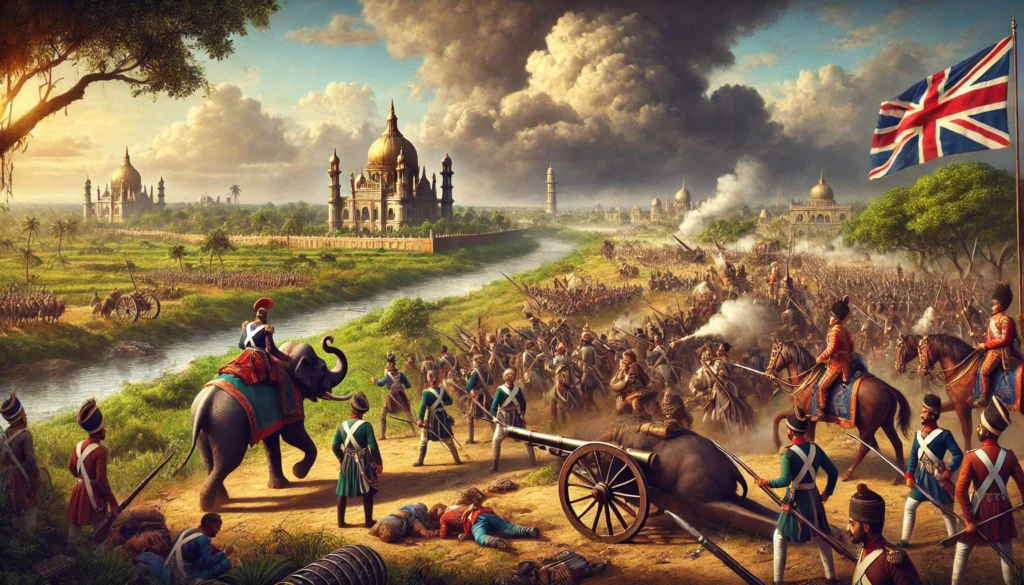
The Battle of Plassey 1757: The Start of British Rule in India
The Battle of Plassey may not seem like much at first glance—a single-day conflict in 1757 between the British and the Nawab of Bengal. But in reality, this event turned the course of Indian history forever. It was a game-changer, marking the beginning of British colonial rule in India and reshaping our nation's destiny.
Let’s dive into why this battle was so significant and what lessons we can still draw from it today.
Why Did the Battle of Plassey Happen?
During the mid-1700s, Bengal was a wealthy province, the crown jewel of the declining Mughal Empire. It attracted both traders and rulers from far and wide. The British East India Company, however, wasn’t content with just trading—they wanted control.
At the heart of this power struggle stood Siraj-ud-Daulah, the Nawab of Bengal, a young leader trying to defend his province from foreign domination. The trouble started when:
- The East India Company began building fortifications in Calcutta (Kolkata) without the Nawab’s permission.
- The company refused to pay taxes, further angering Siraj-ud-Daulah.
- The British aligned themselves with discontented members of Siraj’s court, creating internal rifts.
In retaliation, Siraj-ud-Daulah seized Calcutta. That action set the stage for the fateful confrontation at Plassey, near Murshidabad, on June 23, 1757.
What Happened During the Battle?
The Nawab’s army was massive—about 50,000 soldiers, compared to the East India Company’s 3,000 troops. But what the British lacked in numbers, they made up for with strategy and betrayal.
- Robert Clive, who led the British forces, used diplomacy and bribes to secure the loyalty of key figures in Siraj-ud-Daulah’s camp. The most notable was Mir Jafar, Siraj’s own commander, who turned against him during the battle.
- On the battlefield, the British artillery and trained infantry overwhelmed the Nawab’s uncoordinated troops.
- Heavy rains further disadvantaged Siraj’s forces, as their gunpowder supplies got soaked, leaving them vulnerable.
The battle was over by the afternoon, and Siraj-ud-Daulah fled, later captured and executed.
What Changed After the Battle of Plassey?
1. British Takeover of Bengal
With the victory, the British replaced Siraj-ud-Daulah with Mir Jafar, a puppet ruler who acted in their favor. Bengal’s wealth became theirs to exploit, giving the East India Company immense resources to expand their influence in India.
2. Economic Exploitation
The British drained Bengal of its riches, leading to severe economic decline. This set a pattern of exploitation that continued across India.
3. The Rise of British Rule
The Battle of Plassey wasn’t just about Bengal. It was the first step toward the British transforming from traders to rulers, eventually taking control of all of India.
Why Is This Battle Still Important?
Understanding the Battle of Plassey is crucial because it reminds us how a mix of internal divisions and external manipulation can change the fate of a nation. It also highlights the resilience of people like Siraj-ud-Daulah, who stood up against a powerful foreign force despite overwhelming odds.
Conclusion
The Battle of Plassey wasn’t just a conflict—it was the start of a long colonial history that changed the face of India. Reflecting on such events helps us better appreciate the struggles of the past and shape a stronger, united future.
External links
For more detailed insights into the Battle of Plassey (1757), visit the official Wikipedia page: Battle of Plassey - Wikipedia.
Internal links
Explore more about Indian Modern History and other key events shaping India's past on our dedicated page: Indian Modern History.
The Private Instagram Viewer is a easy to use tool intended to let you anonymously scrutinize public Instagram profiles without logging into your own account. Whether you’re interested just about a username, want to look someones profile picture in full size, or check out their bio and public posts, this tool makes it quick and private.